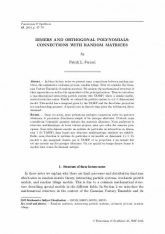Dimers and orthogonal polynomials: connections with random matrices
Dimers and orthogonal polynomials: connections with random matrices

- Consulter un extrait
- Année : 2015
- Tome : 45
- Format : Électronique
- Langue de l'ouvrage :
Anglais - Class. Math. : 82C22, 60K35, 60G55, 60G15
- Pages : 47-79
Dans ces notes, nous présentons quelques connexions entre les matrices aléatoires, le processus d'exclusion simple et les pavages aléatoires. D'abord, nous considérons l'ensemble gaussien unitaire des matrices aléatoires. Nous analysons la structure mathématique de leurs valeurs propres, ainsi que celles des mineurs principaux. Nous introduisons ensuite un système de particules en interaction en dimension~1 (le TASEP) dans lequel une structure mathématique similaire est exhibée. Enfin, nous étendons le système de particules à un modèle en dimension~${2+1}$. Ce modèle a une marginale donnée par le TASEP et sa projection à un instant fixé est une mesure sur des pavages aléatoires. Un cas spécial en temps discret donne le modèle bien connu du diamant aztèque.

